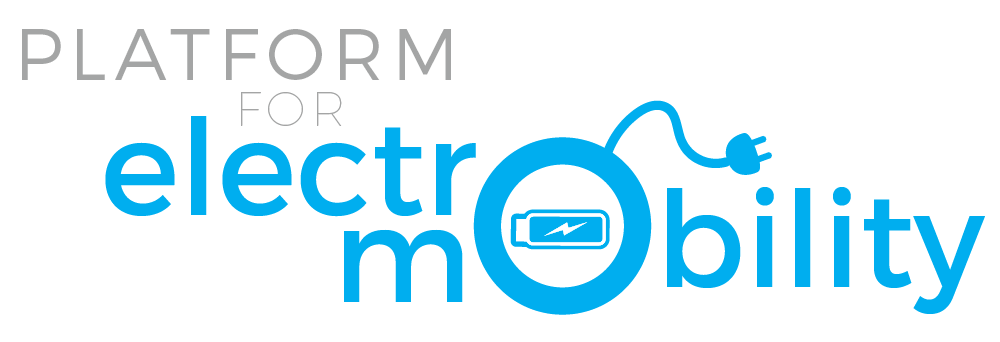EU Election Manifesto: People at the heart of the e-mobility ecosystem
Manifesto Third Pillar
People at the heart of
the E-mobility ecosystem

As Europe shifts to a green economy, the demand for workers in industries such as critical raw materials, batteries and renewable energy industries will grow. Therefore, it will be essential to allocate EU resources and support to help steer young people into those technical fields essential for the green transition. There should be communication campaigns aimed at raising the visibility – and value – of these technical fields. It will also be crucial to implement well-funded reskilling programmes that will attract workers away from existing traditional industrial sectors and into emerging sectors such as renewable energy, grid management, infrastructures and recycling. These programmes will upgrade workers’ skills, train future workforces and ensure a just transition for the workers, their employers, and regional authorities.
The wider adoption of electric vehicles and rooftop photovoltaic solutions offer significant opportunity to unleash ‘prosumer potential’ in Europe. Restructuring Europe’s electricity market will allow us to maximise this potential, specifically through creating opportunities for Vehicle-to-Grid (V2G) where appropriate. This would enable EV drivers to take an active part to the transition by supplying power back to the grid. Allowing them to be rewarded for providing additional grid capacity and thus making the energy system more dynamic and resilient.
It is critical that zero-emission mobility is affordable to everyone. To that end, both old and new electric mobility solutions must be scaled up across Europe: Existing facilities include public transport offerings, shared cars and e-bikes for situations where individual cars are unnecessary. When they are unavoidable, newer solutions include low-cost leasing options, targeted purchase incentives policies and industrial strategies that support the deployment of smaller, more-efficient battery models should be provided. The rapid uptake of electric vehicles within corporate fleets will accelerate their second-hand availability. Implementing the Climate Social Fund should help drive this transition with the least possible impact on lower income families.

EU Election Manifesto: Investment Plan to Implement the Green Deal
Manifesto Second Pillar
An Investment Plan
to Implement the Green Deal

The 2023 Net Zero Industrial Act and the Critical Raw Materials Act needs an accompanying European Net-Zero Infrastructure Investment Plan. A long-term, easy-to-access investment facility – aimed at sectors key to Net Zero – should be a core issue during the European elections.
Freight and logistics infrastructure are a vital component in the movement of goods within Europe. There should be comprehensive investment in developing and deploying sustainable logistics infrastructure. The key elements for decarbonising freight in Europe while remaining competitive are the roll-out of high-power charging infrastructure required for deploying electric trucks of all ranges, the completion of a high quality, interoperable rail network with very high-speed connections, while ensuring a level playing field with other non-emitting modes of transport of goods.
Europe must also improve support for urban transport. Cities are working to accelerate the modal shift and to increase the electrification of their vehicle fleets. To avoid cities becoming the weakest links Europe should be providing parallel support to investments in zero-emission public transport networks and to the deployment of smart and efficient charging infrastructure within urban areas. To support the required local infrastructure investments, the next Connecting Europe Facility (CEF) transport programme should include a dedicated budget for urban nodes, building upon the experience of the Alternative Fuel Infrastructure Facility. Further support from EU research and innovation programmes as well as guidance, will also be needed to overcome challenges such as the constraint of public space, uneven distribution of private investments in EV charging infrastructure in cities or their integration in multimodal hubs, as well as lack of grid capacity.
Net Zero Sectors include the sustainable mining, processing and recycling of critical minerals and metals, modernising power grids and facilities for industrial material recovery as well as renewable energy production. Although existing European funds could contribute significantly, prioritising access to the current EU funding mechanisms and tailoring them to the specific needs of the sustainable transports value chain participants is essential.
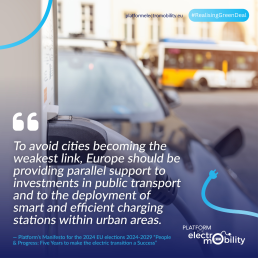
EU Election Manifesto: A Green and Just Industrial Policy
Manifesto First Pillar
A Green and Just
Industrial European Policy

One of the richest ‘urban mines’ available to Europe is the supply of old batteries and other waste materials. By investing in integrated recycling and repurposing facilities for collecting, dismantling, recovering or reusing valuable metals from batteries, Europe can, by 2040, secure a large share of the metal resources it needs for battery production. Such an approach not just reduces waste, it is also scalable, preserving and reusing precious raw materials and keeping a greater proportion of them within Europe, increasing our strategic autonomy.
The overall concept of Europe keeping potentially valuable waste within its borders is one that should be widely adopted. Environmental recycling standards vary; exporting waste for processing to locations without equivalent standards undermines our own attempts to reduce environmental impacts. The EU should encourage recycling by establishing a harmonised approach to the intra-EU shipment of spent batteries. All. Executed properly, this can make Europe competitive in battery recycling, ensure the highest environmental standards and help create a flourishing recycling industry in the future
Resilient, affordable renewable energy will be key to a successful industrial policy; however, this demands that the correct grid assets are in place. With a European Grids Package, Europe can refresh and upgrade its infrastructure to meet the demand to accommodate higher levels of renewable energy. Although this will require investment, doing so will allow Europe to tap into its future grid asset – electric vehicles. It will accelerate the connection of chargers and other Green Deal enabling technologies and allow Europe to tap into the huge energy storage potential offered by electric vehicles.
Europe must also go further than simply reducing vehicle engine emissions; it needs a more-holistic approach to reducing the environmental footprint of all road vehicles. This means decarbonising manufacturing materials, increasing manufacturing efficiency and maximising the circularity of the materials used. Introducing digital product passports, revamping EU products policy to reduce environmental footprints and committing to deliver a strong end-of-life vehicles regulation based on low carbon and recycled materials, will be the key drivers for such change in the years ahead.
Finally, while a renewed European industrial policy has focused on key components and sub-systems, it is important that it considers the full scope of the mobility industries’ value chains supporting their global competitiveness as they address the green transitions.
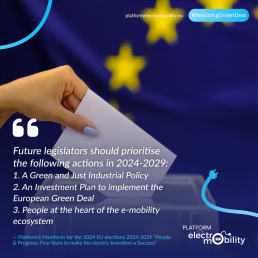
Our statement on the reform of the Electricity Market Design
Electricity Market Design
The Platform for electromobility urges ambitious adoption of EMD reform to drive grid-friendly e-mobility
The Platform for electromobility, uniting industries, civil society organisations and cities from the transport, energy and clean tech sector, welcomes the Electricity Market Reform (EMD) proposal as an important opportunity to support the build-out of grid-friendly e-mobility across Europe. We appreciate the proposals improve the existing electricity market framework in a way that facilitates cost-effective deployment of individual or aggregated smart and bidirectional electric vehicles (EVs) charging. As the EV market is growing rapidly, smart and bidirectional charging will quickly become one of the most important sources of demand-side flexibility. In the collective European effort to decrease fossil gas imports, EV charging flexibility will be instrumental to reduce consumer costs, greenhouse gas emissions and better integrate solar and wind in the grid. Importantly, by offering additional revenues or cost saving opportunities to EV owners, the reform accelerates EV take-up and the clean transport transition.
The Platform therefore urges co-legislators to keep the level of ambition and a swift adoption. The European Commission’s EMD reform proposal supports the uptake of e-mobility in the following ways:
The reform recognises EVs as flexibility resource
Member States will have to make a detailed assessment of the needs and the potential of demand-side response and storage. Based on the assessment, an indicative objective shall be set and supportive measures, such as a flexibility support scheme, may be introduced. It is important to properly include EVs as a source of demand response and storage in both the assessment of the flexibility needs and the objective for demand response and storage, and ensure appropriate participation of EV stakeholders in these assessments processes.
The reform further supports the participation of EVs in the markets
The threshold for participation in the day ahead and intraday markets get lowered to 100 kW, which makes them more accessible to aggregations of EV fleets. This will help develop the market for user-centric smart and bidirectional charging services. It may be advisable to extend this lower threshold also to capacity markets.
The reform accelerates planning for EV charging infrastructure
Transmission and distribution system operators will be financially incentivized to fully consider local demand side resources, such as EVs, when looking for solutions for grid congestion. System operators will propose further transparency and proactivity on their planning for connecting EV charging infrastructure, for example by sharing hosting capacity available for EV charging. This is essential information for providers of EV charging services and helps accelerate grid-efficient build-out of EV charging infrastructure.
The reactions from the electric mobility ecosystem on Net Zero Industry Act
Green Deal Industrial Plan:
the reactions from the electric mobility ecosystem on Net Zero Industry Act and State Aid framework.
The Platform for electromobility welcomes the European Commission’s Net Zero Industrial Act (NZIA) and Temporary Crisis and Transition State aid Framework (TCTF) for accelerating the transition of the EU’s net zero industrial sectors towards climate neutrality by 2050. As currently proposed, the NZIA is a positive start for a necessary holistic and long-term strategic plan, detailing specific financial and regulatory support measures for addressing all global current and future challenges, securing an EU-built industrial ecosystem of sustainable transport and ensuring bespoke strategic autonomy for every key sector identified.
We understand and welcome the package of both NZIA and TCTF as a tool for accelerating clean-tech industries with proposed non-financial regulatory measures. In this paper, we outline how the narrow scope of the proposed NZIA may fail in its aim of supporting European specificities. In addition, certain financial measures should also be included; without these, the NZIA may fall short of achieving its intended goals and fail to provide the required support for European clean industries.
Scope
Given the importance of reducing greenhouse gas emissions from the transport sector and industries, and the fact that Europe’s transport systems make up part of its critical infrastructure, we consider that mobility industries that provide zero-emission vehicles (ZEV) – all transport modes considered – as well as charging stations, software and other ZEV enabling tech, should be considered part of the ‘Clean Tech’ sector.
We welcome the inclusion of battery, charging infrastructures and grid technologies in the Annexes as Strategic Net Zero Technologies, yet we remain concerned about the lack of recognition for the entire EV value chain in the proposal. Net Zero Technologies should be extended to include other EV enabling technologies, including smart and bidirectional charging as well as component manufacturers.
A more flexible approach to those sectors that will be key for the EU’s future competitiveness should be adopted. Downstream industries, such as ZEV manufacturers, should be better considered and included in the scope of the Regulation to secure economic opportunities for supported upstream industries, such as cell manufacturing. Considering the NZIA as a non-financial tool, extending the scope to other sectors of the energy transition would increase Europe’s ability to be competitive in strategic sectors for the decarbonisation of transport, without undermining the support of already-included sectors such as battery manufacturing.
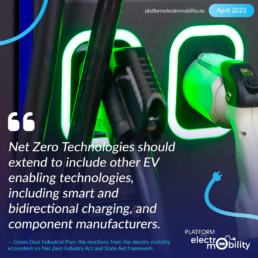
Non-financial measures
To create the enabling conditions for the European clean transport industry to prosper, several issues must be urgently tackled.
The Green Deal is the EU’s centrepiece climate policy. It is now necessary to provide the regulatory certainty for businesses that will allow them to invest in the transition of the EU economy to a sustainable model that is consistent with the 2050 target of climate neutrality. Europe should lock-in ambitious Green Deal Fit for 55 policies (including the Trans-European Network for Transport Guidelines revision, the 2035 zero-emission objective for new cars and vans) and introduce similar policies for trucks and non-road mobile machinery in order to phase-out fossil trucks between 2035-40.
As specified in the proposal, and in order to ensure regulatory certainty, it is important that Member States endorse and adopt legislative and non-legislative actions relating to the Green Deal Industrial Plan. Such actions should be incorporated into national planning processes and should prioritise clean industries in energy and climate plans. New measures should also align with existing governance regulations and contribute to national energy and climate goals. National Recovery Resilience Plans should address the new elements from upcoming regulations, and the ways in which clean value chains can support energy and climate targets.
For the forthcoming mid-term revision of the Multiannual Financial Framework, we welcome recent guidelines pushing Member States to amend National Recovery and Resilience Plans towards energy independency via renewable energy deployment and greening industries. Given the strong synergies between renewable energies and electric mobility, the former will inevitably form a key pillar of a European sustainable, electric transportation system.
We welcome NZIA’s measures for reducing unwieldy bureaucracy and speeding up overly cumbersome and slow procedures for the granting of permits, through national single points of contacts and maximum durations for permitting procedures. The ‘regulatory sandbox’ approach for new technologies can also help support their faster market readiness.
More could be done, however, through a critical review of the sectoral regulation applicable to existing zero-emission industries or technologies, to accelerate product development, capacity for sustainably extracted raw materials and renewable energy, validation, certification and market access, wherever possible. Sectoral action plans could draw on the Mobility Ecosystem Transition Pathway released by the Commission in March 2022.
In order to fast-track best-in-class projects, we welcome that Member States will be required to appoint a contact person for net zero strategic projects.
For modernisation, more should be done to digitalise the approvals process and to increase expertise and skills in local and national authorities.

The Platform supports provisions oriented towards a more binding approach to sustainability / Most-Economic Advantageous Tender (MEAT). The NZIA proposes specific sustainability and resilience criteria that public authorities need to take into account during public procurement procedures, in addition to price or cost. Public authorities shall give the tender’s sustainability and resilience contribution a weight of between 15% and 30% of the award criteria. This goes beyond the only price criteria, and is aligned with the MEAT principle, which is of great importance for the transport sector.
The question of which criteria for which technology should not be tackled in great detail within the NZIA, but rather in some upcoming guidelines from the European Commission. These would support public procurement authorities grasping sustainability and resilience criteria.
In the longer term, improved coordination between universities and industries on European research strategies and priorities is essential: Europe is home of many leading research institutes, but the research sector is overly fragmented to be able to outperform some global regions in the race to develop clean tech. The role of Horizon Europe and of Public-Private Partnerships should be reinforced to address this. European research institutes are also vital in equipping the European workforce with necessary skills for the transition.
The introduction of Net Zero Academies in the NZIA goes in the right direction, but these would require more details and specification. For example, the United States’ IRA has conditionality measures to link public support with social policies at company level. The EU should support companies in their commitment for upskilling and reskilling their workforce. It should foster and promote synergies between public and private sectors, in order to create training programmes fit for the net-zero value chain, such as the ReKnow University.
Financial measures
We welcome the simplification of EU State Aid rules in terms of Aid intensity, eligible costs definition and higher thresholds for State Aid exempted from prior notification for a temporary period. This is a useful immediate measure that will support investments in the electromobility value chain in the EU.
Subsidies should be granted to projects that match a certain set of conditions. This way, public funding (to support Operational Expenditure – OpEx and Capital Expenditure – CapEx) will be directly linked to key parameters for ensuring the competitiveness and resilience of Europe’s electromobility industries for all transport modes. This will be in line with EU targets on, for example, sustainability and R&D&I as well as health, safety and environmental standards.
Specifically on batteries, we support the changes introduced in the revised Temporary Crisis and Transition Framework, which – if leveraged effectively by countries – have the potential of loosening national state aid rules to support EU-based battery production. Financial support should focus on the processing and refining of those battery materials required within the European Union. To ensure predictability and bankability for companies looking to invest in EU-based battery material production, any financing mechanism should be based on clear, pre-determined criteria and focus on output production, similar to the production-based incentives (USD/kWh) introduced by the US IRA.
However crucial the update of State Aid rules may be, the requirement to preserve a level-playing-field between European companies based in different Member States, since some are more fiscal liable and thus more likely to subside industries than others. Fragmentation of the internal market is a genuine risk:
Consequently, European competitiveness and a level European playing field require joint EU funding to ensure a pan-European investment capacity. The future European Sovereignty Fund must be established in close coordination with European clean tech industries, to ensure its cost-effectiveness, added value and complementarity with existing EU funds. ZEV-related supply chains, refining and processing materials for battery production capacity and related grid upgrades should be priority sectors for its operations, and inspiration should be drawn from the simple support provided, for example, in the US IRA, with its Advanced Manufacturing Production Credits. Without such matching of funds, there can be no global level-playing-field for battery manufacturing.
Financial measures should prioritise the development of a European battery value chain, including cell and component manufacturing, critical metals refining and processing. This should introduce minimum production targets for companies manufacturing in Europe (this can be via tax breaks or grants to scale-up manufacturing, or direct subsidies for startups who could be excluded from tax credits/deduction due to limited taxable income), uphold Europe’s environmental acquis and remain focused on the most value-added parts such as cathodes and cathode precursors. Batteries are central to scaling up ZEV and renewables. Missing this value chain to Asia or the US will undermine Europe’s strategic resilience and exclude the bloc from the resulting industrial and jobs benefits.
For battery manufacturing, the US IRA provides an Advanced Manufacturing Production Credit (Opex support) of $35/kWh produced. We call for EU policymakers to match such support in order to help its European battery industry compete on more equal terms. Without such matching, there can be no global level-playing-field for battery manufacturing.
In parallel, Europe’s competitiveness and leadership on downstream industries (road and rail vehicles manufacturing) must be enhanced through dedicated, co-created action plans. Europe should also reward an accelerated implementation of the carbon footprint, circularity and due diligence provisions in the new EU Battery regulation by targeting subsidies at companies leading on sustainability.
Funding should support urgently-needed investments in grid upgrades and capacity, training and reskilling. There should be a specific focus on ensuring that workforce shortages in the electrical and software sectors are urgently addressed. This should go beyond financial mobilisation through the existing opportunities set out by the European Commission (Innovation Fund, Invest EU, Recovery and Resilience Facility; Horizon Europe and cohesion policy programmes), which have not yet reached convincing scale or momentum. To support its ambitions, the European Commission should come forward with a concrete funding plan/guideline to support the deployment of Net-Zero Technologies.

CO2 Standards for trucks and buses: our reaction
Recommendation paper of the Platform on the revision of the HDV CO2 emission standards following the Commission’s proposal
The Platform for electromobility very much welcomes the proposal by the European Commission for revision of the CO2 standards for heavy-duty vehicles (HDV) and sees the regulation as a fundamental tool to electrify trucks and buses and thus advance the rapid roll out of zero emission vehicles (ZEV) in the road heavy transport sector. Currently, trucks and buses together make about 27% of the EU road transport emissions and trucks make up more than three quarters those. The proposal of the Commission for the revision of HDV CO2 standards falls short to align the CO2 targets for the sector with the EU’s overall -55% GHG reduction target in 2030 and the climate neutrality target of 2050.
In order to transition the road freight sector to zero emission, more ambitious standards are needed to set the right pace and a clear trajectory for manufacturers, logistics operators as well as for the supply chains in the electromobility and automotive industry. Scaling effects in production and technology development in the e-mobility and transport sector contribute to making electric HDVs more competitive and widespread.
Uniting ambitious green supply-side policy making with investments into cleantech industries, as done with the Net Zero Industrial Act, allows Europe to remain a climate leader whilst paving the way for thriving industries. The Platform calls on the European Parliament and Member States to notably strengthen the targets of the HDV CO2 standards, reducing emission, air pollution levels and setting pace for a greening road transport sector.
Almost all newly registered trucks should be 100% zero emission at the latest by 2035, including small, medium and large trucks considering the average lifespan of a truck of roughly 15 years. Non-regulated vehicles, such as vocational vehicles, should be put on a track to zero-emission by 2040 with the help of a ZEV mandate. Small trucks between 3.5-5t are possible to decarbonize within a few years as truck models are available and they can be operated without hurdles already today. These trucks are currently not part of the scope and should be included with a 100% ZEV mandate by 2030.
The Act should consider the demand for strategic raw materials across all e-mobility sectors. Batteries are of critical importance for the success of the EU Green Deal. The competitive environment in which battery manufacturers operate has evolved significantly since the first EU Battery Action Plan was developed in 2018. The Act offers the opportunity to update the EU Battery Action Plan and articulate the steps that Europe should take to support battery roll out.
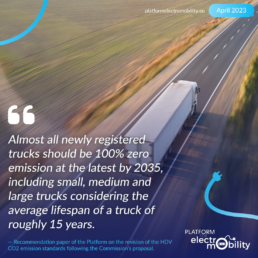
The proposal’s new definition of zero emission (5 gCO2/tkm) creates a dangerous loophole for continuous sales of emitting vehicles even after 2050. The current definition requires trucks to emit less than 1 gCO2/kWh. The change of definition in the proposal allows for dual-fuel trucks running on 10% polluting diesel to be called zero-emission. The Platform strongly advocates to further only truly clean and future proof technologies and reverse the definition of ‘zero-emission’, and asks to keep it as it is (1 gCO2/kWh)

Sourcing should be both adequate and sustainable. The legislation should focus on ensuring an availability of supply that respects both human rights and environmental standards, regardless of the country of origin.
The global CO2 emission reduction targets for lorries as well as coaches should be significantly increased to align it with Europe’s 2030 climate target and market feasibility considering the sales targets by heady duty vehicle makers of up to 63% zero emission by 2030 . The proposed 2030 target of -45% is lacking ambition and is below what manufacturers have announced. It should be increased to an emission reduction level of at least 65%. An ambitious early target is key to breaking the cost barriers by unlocking rapidly improving battery technologies and by profiting from efficiency gains of ZEV series production.
The platform very much welcomes energy efficiency targets for trailers and semi- trailers as they will be a catalyst and accelerator for additional emission reductions.
An intermediary target should be included with a 70% ZEV mandate by 2027 considering that in 2022 30% of new buses in Europe were already zero emission , allowing city buses to move on a faster emission-free trajectory. As the bus target is counted towards the global CO2 emission reduction target, manufacturers have additional flexibility to reduce their emission by producing ZEVs in either of the categories – buses or coaches.
Two subcategories of urban buses, namely class II low-entry (i.e. 31L2 and 33L2), should be moved into the coach segment, as they are often used by local and regional authorities for longer distance public transportation. A usage that will be more difficult to decarbonize by 2030. In parallel, coaches, therefore including class II low-entry, should have the following CO2 reduction targets: 20% ZEVs by 2027, 60% by 2030 and 100% by 2035.
Policy makers need to create enabling conditions for transport operators and local and regional public authorities to transition to zero emission, such as sufficient funding opportunities for buses and infrastructure as well as assured grid reinforcements. In cases where recent investments into low-emission infrastructure have been made, an extended deployment of the existing bus fleets beyond their average lifetime can be made.
More clarity on the exemptions introduced by Article 3.b. would be needed as the content of the upcoming Delegated Act are not known yet and give the exemption a high level of unpredictability. The “maximum share of vehicles that a Member State can exclude” should be limited to the maximum level that does not jeopardize the strength and very meaning of the target. In addition, MS should strongly and objectively demonstrate and motivate the reasons for asking for the exclusions.
In order to help city councils and operators lower the cost of bus electrification, the best price-quality ratio criteria in the new public procurement procedures (article 3c) should include not only the provision of buses but also other services as the installation of the depots and on-road charging infrastructure and their operation and maintenance.
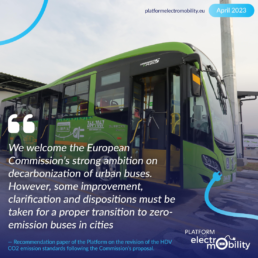
• The platform supports the Commission’s decision not to include a crediting mechanism for renewable and low-carbon fuels under this regulation. Under such a mechanism, manufacturers could continue to produce ICE vehicles and delay the transition to zero emission ones whilst not actually being able to control how fuels are being used in the end (and still being rewarded for it). In addition, incentivising these fuels are incompatible with EU efforts to increase efficiency and reduce energy consumption in HDVs.
• The ZLEV mechanism should be transformed into a ZEV only mechanism and as proposed phased out by 2030 when significant market ramp-up for zero emission trucks and buses can be expected.
• The possibility of transferring of zero-emission vehicles between non-connected manufacturers should be maintained. However, in order to create a large-enough market place for trading between manufacturers, co-legislators should remove the proposed 5% cap for receiving manufacturers.
• There should not be an exemption for small volume manufacturers as it is a contrary measure to reach carbon neutrality by 2050.
• The extension of the emission debts and crediting system from 2030 to 2040 gives additional flexibility to manufacturers to earn credits (when reducing emissions more than required) and use them to offset debts (if emissions are above what is required). Credits now can be used for 15 years to offset debts. Credit’s lifetime should have a maximum of 5 years as do the debts, have now. This would force to continuously investing in reducing their CO2 emissions.
• Protect the penalty scheme, which will force OEMs to take decarbonisation seriously. The currently existing excess CO2 emissions premium (penalty) should not be subject to the development of public infrastructure as many first-movers will aim for depot charging for their operations.
• Set a future-proof definition of long-range ZEHDVs. The European Commission proposed a threshold of 350 km as the definition for a long-range ZEHDVs. This should be increased to 450 km to accommodate the latest developments of improved battery designs that are offering longer ranges.
The ambitious charging infrastructure targets as finally adopted in the AFIR enabler a successful rollout of ZEVs. Additional private as well as public investments are needed to ensure higher grid capacity to serve the growing trucks and buses charging demand. The revenues from excess emission premiums should be channeled back into the sector for the roll out of the infrastructure network.
Investing in reskilling of workers is essential for both, those currently employed in the HDV manufacturing and therefore see a conversion of current skills, and new ones who will be increasingly specialized in new production value-chain. It can reduce social risk and increase labour resiliency. Other measures such as job-search assistance to jobseekers and income and early retirement support could make the transition more “just”.
The positive effects of electrifying trucks and buses are far-reaching and go beyond reducing Europe’s GHG emissions – accelerating the zero emission HDVs roll out also allows to drastically improve noise and air pollution. The high increase of energy efficiency in the case of BETs is particularly beneficial when road transport accounts for 29% of the EU’s final energy consumption[1]. The Platform for electromobility also wants to highlight that the transition to electric trucks and buses is a considerable opportunity for the European e-mobility value chain and the competitiveness of the economy. Ambitious targets would make Europe a leader in zero emission HDVs and thus further unlock the potential of the e-mobility value chain.
[1] https://theicct.org/transport-could-burn-up-the-eus-entire-carbon-budget/
Weight & Dimensions Directive: the hidden milestone for e-trucks
Six points to make the Weights & Dimensions Directive
better incentivize zero emission trucks and buses
The Heavy Duty Vehicle (HDV) segment needs to accelerate its decarbonisation. In 2022, battery electric heavy trucks made up only 0.6% of new truck registrations in Europe. Diesel represented 96.6%[1].
Buses are decarbonising much faster, as new urban bus sales in 2022 saw a higher share of zero emission vehicles – 30%. Diesel buses represented 67.3% of the new sales in Europe[2].
While the CO2 standards for trucks and buses are important in setting decarbonization targets for the HDV sector, they will not solve the issue of incentivizing Zero Emission (ZE) trucks and buses.
ZE trucks will be able to benefit from mandatory toll discounts under the Eurovignette directive and the expansion of ETS to road transport. Currently, ZE trucks benefit from a minimum tax on diesel, and a weight allowance of 2 tonnes more than a diesel truck. As zero emission vehicles weigh more than diesel-powered vehicles due e.g. to the battery weight, the additional weight allowance is a must-have measure for decarbonizing the HDV segment.
Even though the additional weight allowance of 2 tonnes is a good starting point, there are additional measures that can help the uptake of ZEHDVs, which has so far been limited. The proposed revision of the Weights & Dimensions Directive (WDD) provides an excellent opportunity for non-monetary incentives for zero emission trucks and buses in Europe. The European Commission should focus on the following measures:
- Implement clear cross-border rules
- Modify the methodology governing the additional weight allowance
- For long-range ZE trucks, permit one further tonne, linked to range, to a max of 3t
- Allow ZEHDVs a time-limited increase in the maximum authorised drive axle weight
- European Modular System (EMS) should be zero-emission by 2028
- Set explicit time limits for WDD transposition and type-approval
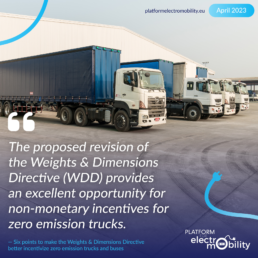
- Implement clear cross-border rules
As it stands now, the WDD enables the additional weight allowance only at border crossings of 13 EU Member States as the weight allowance only applies at borders of countries that have the lowest authorised vehicle weight. Furthermore, it does not provide an incentive for ZE HDV activities at the national level.
The current WDD has led to disputes between Member States on the allowed weight of HDVs on border crossings. In order to avoid any new disputes and remove the existing ones, the EC should develop rules that apply to the entire EU and not to selected border crossings.
The Benelux countries have done exactly that in 2022[3]. Although Benelux countries have different authorised weight allowances, when freight vehicles cross borders, the lowest weight limit in both countries is applicable. And for zero-emission vehicles, the additional weight allowance is automatically added.
Therefore, the European Commission should expand the scope of the WDD and clearly define that:
- The lowest authorised weight limit at border crossings is equal to the lowest authorised weight limit between two adjoining Member States;
- That the additional weight allowance for ZE HDVs is automatically added to the lower authorised weight limit;
- The additional weight allowance applies also for national transport.
- Modify the methodology governing the additional weight allowance
In practice, the current system requires the vehicle-maker to present a diesel comparator, with up to 2 additional tonnes then allowed above the weight of the comparator vehicle.
This system causes issues for new ZE vehicle-makers, which by definition, don’t have comparator vehicles to reference.
The WDD revision should grant some flexibility to new entrants by saying that the relevant authorities must have due regard to the position of new entrants in the selection and assessment of comparator vehicles.
- For long-range ZE trucks, permit one further tonne, linked to range, to a max of 3t
Up to ranges of approximately 400km, the additional 2t already granted is sufficient. Beyond this range, however, the allowance should be increased according to greater range provided. We suggest 2.5kg per km of ZE certified range above 400km to a maximum of 3t (i.e. the maximum is reached at 800km).
- Allow ZEHDVs a time-limited increase in the maximum authorised drive axle weight
The change most sought by truck and bus-makers is an increase in the maximum authorised axle weight placed on the axle connected to the zero emission powertrain, more commonly known as the drive axle. Today the weight limit applied to the drive axle is 11.5t, and due to the higher weight of ZE powertrains (e.g. batteries), truck and bus-makers ask that this limit be raised to 12t. This ask concerns two-axle tractor units and buses in the EU, which are the most-sold configurations.
On the one hand, such a change would boost the pace and scale at which zero-emission trucks and buses are deployed. On the other hand, without safeguards and phase-down dates, it could increase road wear.
Therefore, we advocate considering this change on the basis of a number of safeguards covering:
- tyre configuration and maintenance;
- the speed at which such vehicles can take off from a stopped position (“acceleration from rest”); and
- timeframe, namely that ZE truck & bus-makers can deploy 12t drive axles – under certain conditions – until a certain year (2029 for trucks).
Taking each of these in turn, for a qualifying vehicle, it would be necessary to deploy:
Tyres
- On the steer (front) axle, wide base high-efficiency tyres
- On the drive (rear) axle, dual tyre configuration (assembly) using high-efficiency tyres
- A Tyre Pressure Monitoring system that alerts the driver to a loss of pressure any greater than 0.5 bar, and with a duty to restore pressure to recommended levels at the nearest available facility having regard to the direction of travel
Acceleration limiter
- Ensuring take-off-from-rest is between 1 and 1.2m/s2
Timeframe
- 4×2 ZE trucks registered from entry into force [in ~2026] to 1.1.2029 can carry 12t on the drive axle – once the above conditions are met
- More flexibility on the end date could be considered for buses (and coaches) given their smaller sales numbers.
- European Modular System (EMS) should be zero-emission by 2028
There are calls across the trucking sector for more opportunities to use EMS. However, it can only be guaranteed that EMS will reduce emissions if the trucks are ZE. Therefore if proposals are made to permit cross border EMS, it can only be by ZE trucks, and where each route is checked and approved by the relevant authorities for road safety (i.e. that approach roads used to access the highway are suitable for EMS movement) and freight modality (coherence with overall freight policy goals).
- Set explicit time limits for WDD transposition and type-approval
The WDD does not have a formal time limit for transposing the existing 2 tonnes weight allowance into national law. This needs to be done as soon as possible as the business case for long-range zero emission HDVs depends on clear rules across Member States.
As the previous transposition of weights and dimensions rules to type approval law took four years, it is important to set a stricter deadline. This will enable manufacturers to achieve the recently proposed HDV CO2 reduction targets.
Critical Raw Materials Act: Reaction paper of the Platform for electromobility
Critical Raw Materials Act :
Reaction paper of the Platform for electromobility
The European Commission’s proposed Critical Raw Materials Act is a much-needed initiative in today’s world. Demand for critical raw materials (CRMs) will continue to increase, in order to underpin a sustainable transport system in the near future. Indeed, the proposed Act aims to ensure the sustainable supply of those CRMs essential for electric mobility-enabling sectors, electric cars themselves and renewable energy technologies. We particularly welcome the Act’s efforts to balance resilience, security of supply and environmental protection with the new focus on refining and remining, which are crucial steps in producing and securing CRMs. ‘Refining’ refers to the process of purifying raw materials, which can reduce the waste and environmental impact of their extraction. ‘Remining’, meanwhile, involves the extraction of raw materials from the waste or by-products generated during the production process or from legacy mining sites.
Furthermore, the Act also stresses the importance of the responsible extraction and processing of CRMs. This includes promoting the use of new and innovative technologies for reducing the environmental impact of extraction and processing activities. By adopting these measures, the European Union (EU) can lead the way in sustainable mining practices, while also ensuring the ongoing availability of critical raw materials for the production of high-tech products. These measures will also help reduce the dependency of the EU on raw materials sourced from outside its borders, thereby ensuring a stable, sustainable and secure supply of these much-needed CRMs.
For these reasons, the CRMs Act proposed by the European Commission is a generally welcome initiative, one which can help ensure the sustainable supply of critical raw materials. However, the following addition improvements, proposed by all members of the Platform for electromobility, from NGOs to industries, should be considered by co-legislators:
While the Hydrogen bank is properly linked to an innovation fund, the Commission’s proposal fails to link a clear funding mechanism to the investment activities needed to reach objectives. This is particularly salient for the national mapping and mining prospective activities required to reach the 10% extraction objectives. Funds should be designed to ensure full respect of social and environmental due diligence for new and remining plants.
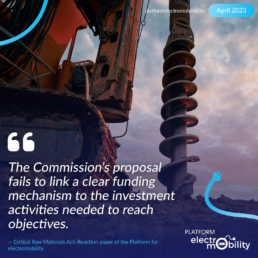
We call for an extremely cautious assessment of the need for stockpiling mechanisms, as they may have unintended negative consequences for the market and for emerging European industries. A robust and exhaustive analysis of the potential effects is essential before putting into place any measures to address short-term supply disruptions.
Thanks to the high recyclability potential of CRMs, the materials notably included in the clean transport can be considered in the long term as a future stock available for European use and consumption. In other words, the rolling stock of CRMs present in Europe’s electric fleet can be considered as the strategic stock Europe needs. Therefore, efforts should be focused on Europe’s recycling capacities rather than its stockpiling requirements. For this reason, the revision of the Industrial Emissions Directive or the REACH regulations should not undermine the competitiveness of recycling in EU, and should also ensure that equivalent conditions for recycling outside of EU are applicable.
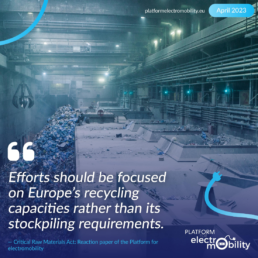
On battery recycling shipment, p.18 of the accompanying ‘Communication’ currently proposes – for 2024 – the inclusion of waste codes for lithium-ion batteries and intermediate waste streams (‘black mass’) under the European List of Waste, in order to ensure their proper recycling within the EU.
We therefore propose to insert this new paragraph:
“The Commission shall adopt a Delegated Act specifying waste codes for lithium-ion batteries and intermediate waste streams (‘black mass’) and setting up a fast-track procedure for their shipment for recycling within the Union.”
The existing barriers to the shipment of end-of-life lithium-ion batteries across EU borders are significant and need to be urgently addressed. The EU therefore needs to clarify the waste classification of spent lithium-ion batteries and give them their own dedicated waste code so that all countries apply the same rules when ruling on their intra-EU shipment. The EU also needs to design a fast-track validation procedure for intra-EU shipment of both lithium-ion batteries and battery materials.
The legislative framework should also be adapted, such as the Waste Management Directive, to keep the results of shredding in Europe and support the development of materials and batteries collection. It is also crucial to facilitate transboundary waste streams such as waste batteries/black-mass, materials scraps (such as aluminium, copper, steel, plastics, rare earths, catalytic converters and electronic components), between EU Member States. This will encourage their recycling within the EU, while better controlling their exports to non-EU countries, thus ensuring the development of a common EU market for CRM rich feedstocks. For example, the inclusion of waste codes for lithium-ion batteries and intermediate waste streams (‘black mass’) under the European List of Waste is a one way to ensure their proper recycling within the EU (as mentioned in the CRM Communication).
It should be clarified as to how the results of the national exploration plans will be made publicly accessible. As a general rule, that which is publicly funded should be publicly accessible.
Concerns can be raised as to the degree of leniency provided to strategic projects by the proposal on their level of respect for the corporate sustainability due diligence requirements. It is important to stress that however strategic a project may be, those requirements must always be respected to ensure a fair and sustainable transition to clean mobility.
In parallel, we would like to question the Act’s requirement for mandatory resilience checks on large entreprises. A number of ongoing legislative proposals (e.g Corporate Sustainability Due Diligence) are already proposing new reporting requirements on European businesses: the issue of additional requirements due to resilience considerations should not be addressed separately but rather in the scope of these instruments.

Similarly, we wish to raise concerns over lack of detail given by the proposal on the proper consideration and calculation of the environmental footprint of CRMs in final products. The PEF (Product Environmental Footprint) is an LCA-based (life cycle analysis) method, developed by the EU Commission. However, other standards for LCA methods exist that also provide environmental impact calculations. This needs to be clarified and should also include a fixed timeline for when the European Commission should propose the relevant Delegated Act.
The CRM Act is part of a broader legislative framework for creating the conditions for a fair, sustainable and competitive transition to clean industries and zero-emission mobility. We invite co-legislators to work closely and in parallel on the Net Zero Industry Act (NZIA) and consider the recently adopted Renewable Energy Directive (RED) and Battery Regulation when amending the CRM Act. They should also be cautious about any increased administrative burden that the new requirements may create. In particular, we call for the alignment of impact assessment processes and authorisations measures, with emergencies measures for renewable energy as defined in in the RED.
The Platform welcomes the proposal to create a European Critical Raw Materials Board to oversee the governance and implementation of the CRM Act. However, it is once again vital for ensuring the sustainability and durability of the clean transition that industry, civil society and NGOs are adequately represented on this board.
Efforts must be made, in the context of the 2023 EU Year of Skills, to increase the coverage of CRMs in University Master programmes and to raise awareness around the issue in our next generation workforce. Skills shortages are particularly acute for geology and low-environmental-impact mining specialties, which are currently only present in regions with active mining industries.
Ad hoc incentives would help develop local and more-sustainable supply chains. Policy actions should be defined carefully, and should assess worthy examples adopted by other countries such as tax incentives and innovation funding. Such an approach would also create new jobs at local level and mitigate potential social impacts relating to the energy transition.
Additionally, skills-based visa schemes for raw material professionals currently based in third countries may help fill existing human capital shortages in the short term.
ERMA will play a key role in ensuring a successful approach to critical raw materials, but needs to be further empowered both in governance and financial terms. It requires a mandate to ensure the achievement of European Strategy targets, leading all European Union initiatives on raw materials endowed with all the necessary levers. The current Alliance mechanism for involving players along the value chain should remain; however, as the investment needed will be relevant, it will also be important to support those initiatives that achieve the critical mass to become game changers. Here, it is fundamental that ERMA should have a full overview of the levers that EU is putting in place (regulatory, financial, etc) and that it should be a driving force in implementing the strategy. All raw materials-related initiatives should fall within the overall ERMA framework.
In coordination with ERMA, each Member State should create a National Raw Material Agency (NRMAg) aimed at leading and implementing the national strategy. The structure, tasks and resources of NRMAg should comply with minimum framework requirements as defined at European level.
Conclusion
The CRM Act proposed by the European Commission is a much-needed step in securing the supply of raw materials essential to the EU’s economic and strategic interests. The Act acknowledges the increasing demand for critical raw materials, as well as their limited availability, and aims to establish a comprehensive framework for ensuring their sustainable and responsible sourcing.
However, there are some concerns and reservations that need to be addressed to ensure that the Act is fully effective. First, it must balance the need to secure critical raw materials against environmental and social sustainability, as well taking account of ethical considerations. In addition, it is essential to ensure that the implementation of the Act does not lead to trade barriers or lead to unfair competition that could ultimately harm the EU’s industrial competitiveness.
Careful consideration and monitoring are needed to ensure that the implementation of the CRM Act is effective, sustainable and equitable. By addressing these concerns and reservations, the EU can pave the way for a more resilient and sustainable supply chain for critical raw materials, while upholding its values and commitments.
Strengthening EU’s electromobility ecosystem in the global race.
Strengthening EU’s electromobility ecosystem in the global race.
The investment in manufacturing technologies required to develop the net-zero, clean technologies and renewable energies is urgently needed at European and global levels. The Platform for electromobility therefore welcomes the ambition shown in the European Commission’s Green Deal Industrial Plan, which is designed to improve a number of European policies in response to the new industrial ‘Inflation Reduction Act’ (IRA) in the United States.
Given the importance of reducing greenhouse gas emissions from the transport sector, and the fact that Europe’s transport systems are part of its critical infrastructure, we believe that mobility industries providing zero-emission vehicles – all transport modes considered – should be considered part of the ‘Clean Tech’ sector. This should also extended in order to include charging stations, software and other EV enabling tech, given their important manufacturing footprint in Europe. This way, it will help anchor the manufacturing facilities for EV chargers on our continent.
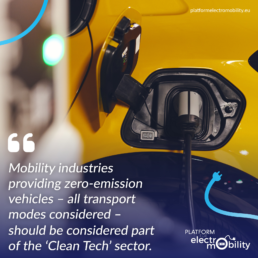
An effective European response should go further than the IRA, and rapidly ensure the resilience of European industries against a backdrop of growing geoeconomic challenges. These have already seen both the United States and China invest heavily to try to secure the control of the electric mobility industrial value-chain.
Together, the IRA and the Made in China 2025 (MIC) plan should be treated as a wake-up call and a trigger for a robust European response. Indeed, Europe needs a holistic and long-term strategy that sets out the specific financial and regulatory support to address all the global current and future challenges. This should be capable of securing an EU-built industrial ecosystem of sustainable transport, and should ensure bespoke strategic autonomy for each key sector identified.

Importantly, the EU response should be prepared with care, in order to avoid provoking a global subsidy race. The goal should be to create an international level playing field between all economies, aimed at reaching Paris Agreement climate targets (COP21) together.

Disregarding trans-Atlantic subsidies schemes, the European industrial strategy should define a long term-strategic ambition which, as a priority, should support the zero-emissions mobility, along its entire value chain and through all sustainable transport modes.
The Platform for electromobility is willing to bring its expertise and ecosystem perspective to the democratic debate by drafting detailed proposals that would lead way to a) short-term non-financial measures, such as regulatory certainty, bureaucratic delays, energy taxation, European research and shipment rules; b) State Aid rules and European Sovereignty Fund; and c) financial support.
Where the Critical Raw Material Act should critically act
Where the Critical Raw Material Act should critically act
The vital transition away from fossil fuels to cleaner technologies such as electric transportation – cars, trucks, buses, trains and public transport – will drive the demand for raw materials. Lithium, nickel, copper and cobalt will all be required in varying amounts depending on the technologies and applications.
Whilst certain Critical Raw Materials (CRMs) are accessible on the EU territory, Europe remains largely dependent on third countries for mining, processing, refining and recycling. This dependency has been accentuated by current geopolitical events and supply chain tensions, which have led to volatility, increasing prices and uncertainties over global supply. For this reason, we strongly welcome the principle of today’s Commission’s CRM Act, and we will shortly publish a detailed assessment from the perspective of the electromobility ecosystem.
Three clear flaws for Europe on CRMs
In light of the urgently required transition to e-mobility, and the need to ramp up a domestic Electric Vehicle (EV) value chain in Europe, there is a clear flaw; the EU is primarily deficient in domestic capacity beyond that of battery manufacturing. It lacks access to resources to extract, and – critically – the capacity to refine and process, as well as to recycle. Such processes are still undertaken almost entirely in resource-rich, more experienced and more competitive third countries. This is endangering both Europe’s autonomy in CRMs and the respect of the upmost environmental standards.
It is therefore vital that Europe builds its own processing and refining capacity for battery materials, using existing domestic sources of valuable materials. Europe must also increase its recycling capability and competitiveness in order to reduce the EU’s dependence on primary raw materials.
The second flaw is the excessive hurdles to the permitting. In particular, the range of mining codes that exist in Europe creates incoherence and differences in the levels of ambition between Member States, which in some cases may threaten safeguards to social and/or environmental protection. The processes for granting permits becomes excessively lengthy when multiple permits are needed for both renewable energy production and for sustainable mineral extraction projects.
The third flaw is the limited availability of sustainably sourced, highest quality materials, in no small part due to incomplete and limited mapping of geological and remining potentials. There are also barriers to the reuse and repurposing of EV parts, which could extend the lifespan of CRMs prior to recycling, thereby reducing the overall demand for CRMs. Member States lack the expert capacity to ensure the efficient, robust and timely evaluation of Environmental Impact Assessments and Area Assessments.
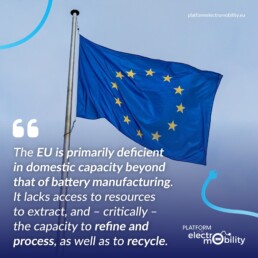
Consequently, the Platform for electromobility wishes to highlight the need for the EU’s Critical Raw Materials Act (the Act) to consider to the following 12 areas:
We welcome the objective of establishing a single European strategy on raw materials that defines expected needs, challenges, priorities and key lines of actions. We also welcome the specific objectives of reducing the need for primary CRMs – with efficient repurposing, reuse and recycling – while maintaining high environmental and social standards and increasing security of supply. The objective of a coherent, EU-wide strategic Act should be to prevent the creation of numerous small initiatives triggering competition within and between Member States, and to develop an integrated and coherent development strategy for allocating resources more efficiently.
The Act should consider the demand for strategic raw materials across all e-mobility sectors. Batteries are of critical importance for the success of the EU Green Deal. The competitive environment in which battery manufacturers operate has evolved significantly since the first EU Battery Action Plan was developed in 2018. The Act offers the opportunity to update the EU Battery Action Plan and articulate the steps that Europe should take to support battery roll out.
Those economic actors meeting the highest existing environmental standards (such as for mine tailings) and social standards (such as community consultation) should be eligible for financial and political support.
Support should cover the development of recycling capacities. This is important because not all recycling activities are currently financially viable, due to the low cost of some primary resources and the lack of availability of recyclable materials. Support for developing recycling capacities is therefore vital to the circularity and sustainability of CRMs sourcing; any barriers to boosting such capacity should therefore be dismantled. In the example of battery manufacturing, circularity implies that valuable recycling resources – such as end-of-life batteries, battery waste, black mass and battery manufacturing waste – must remain available and easily shippable for the European recycling and battery materials industry.
Support could take the form of funding, tax reductions, grants, equity or project finance, granted to those companies who are rethinking the design of their products with a circular approach to reduce their raw material consumption or their use of non-critical substitutes. Furthermore, those companies who can demonstrate effective results in reducing their use of primary materials should presented as examples of good practice by the EC.
Such support would incentivise efforts to keep valuable battery materials in Europe, to keep them available for domestic recyclers. This would justify current investments in such materials in Europe through measures incentivising the recycling of battery manufacturing waste and black mass/BAMM (Batteries Active Materials Mixture).
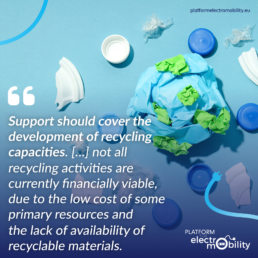
Sourcing should be both adequate and sustainable. The legislation should focus on ensuring an availability of supply that respects both human rights and environmental standards, regardless of the country of origin.
Mechanisms to incentivise the use of secondary raw materials should be introduced, to ensure that secondary sources of CRM (and potentially other common materials) in the EU value chain are used to their full potential. Incentives can take the form of targets. Targets should be flexible enough to allow the European Commission a degree of latitude to help avoid an excessive burden on economic players or creating market distortions.
The list of CRMs should be further developed and updated, potentially evolving from a simple ‘ON/OFF’ list to an actual ranking of CRMs that set a priority (to also be extended to other materials). We think that certain materials (such as silicon) should be given a higher priority.
It is important to integrate the raw material strategy with the objectives already contained in the Circular Economy Action Plan (CEAP), and to include raw materials for green technologies within CEAP priorities. The challenges of decarbonisation and the circular economy must be addressed as a single issue.
The Act should include provisions to de-risk domestic sustainable extraction projects through an EU-wide financial risk mitigation framework, which will ensure investment certainty. Current legislation is not clear on the de-risking process notably for a financial product to de-risk investments in geothermal capacities to extract lithium sustainably. Today, the existence or not of specific financial risk mitigation products required, as an example, for geothermal lithium extraction project development is a determining factor for projects to be given the go ahead or not. Such scheme should be secured at EU level.
Moreover, the Act should also support geological surveys to produce and/or update 3D maps of raw material resources and therefore better determine accessibility of domestic resources.
Alongside this, remining solutions, i.e. mining from existing decommissioned mining sites, should also be considered as integral parts of a sustainable value chain for CRM. Efforts should be made to map this potential and its environmental impact in Europe and subsequently to increase the availability of secondary raw materials. In case of remining, the re-opining of sites should respect all requirements of new ones.
In coordination with ERMA, each Member State should create a National Raw Material Agency (NRMAg) aimed at leading and implementing the national strategy. The structure, tasks and resources of NRMAg should comply with minimum framework requirements as defined at European level.
When solutions for European sourcing (from repurposing, recycling, to remining and mining) are insufficient to meet demand, various options for sourcing CRM internationally should be considered.
For international free trade agreement, due diligence must be considered a basis for negotiating Free Trade Agreements (FTAs) and other potential trade protocols, such as strategic partnerships. This way, we can ensure that imported resources meet Europe’s environmental, economic and social objectives.
Moreover, supporting European stakeholders to directly invest in third countries sourcing capabilities should not be ignored. Acquiring mining capacities in third countries may also be a valuable approach as an alternative to FTAs. With the Act, the EU should also support these ventures when adequate. When using such opportunities, the highest environmental and social standards in third countries should be safeguarded or implemented.
We call for an extremely cautious assessment of the need for stockpiling mechanisms, as they may have unintended negative consequences on the markets and nascent European industries. We do not favour direct market intervention in the form of strategic reserve buying or policies designed around redistribution schemes. Policies designed to build strategic reserves risk artificially inflating prices, which will undermine the development of those European producers of value-added goods who are dependent on these CRMs.
The Act should not yield on any weakening of environmental regulations, but rather should offer the opportunity to safeguard key ones as a condition.
Most importantly, the carbon footprint calculation of the Act should complement the recently adopted Battery Regulation. The calculation for the environmental footprint should be based on the energy mix used at the production phase and that for transport, supported by the appropriate documentation. Details on the Bill of Material and relative origin (primary or secondary raw materials) could be required.
The EU should reduce its dependency on imports of materials of strategic importance for production. Sourcing should take place within the EU and should include the use of secondary raw materials from waste. As not all recycling activities are currently financially viable due to the low cost of some primary resources and the lack of availability of recyclable materials, support for developing of recycling capacities is vital for enhancing the circularity and sustainability of CRM sourcing.
Some products, such as electric motors, may contain CRMs that are not typically indicated on the products. In order to help improve their collection, recovery and recycling, we suggest creating a system of specific and mandatory marking for products containing CRMs (via labels or QR codes, for example), relevant with the European Battery Regulation.
A clear and homogeneous framework for waste regulation is also needed to encourage reuse and recycling, in line with the EU waste hierarchy. Removing administrative obstacles and barriers arising from different legislations can favour the circularity of materials, clarifying limits and opening up new opportunities for enhancing materials, reducing waste generation as a result.
However, excessive recycled content requirements could have the adverse impact of increasing the dependence of European companies. Additional measures should also be considered to make it easier for recycling companies to access black mass from European operations.
Finally, a well-functioning internal market for second-hand raw materials (one with transparent, clear and homogeneous trading rules) would make it easier to implement recycling, repurposing and reuse activities in strategic value chains. This would help minimise environmental and social impacts and enable the development of local specialised hubs.
As highlighted in the introduction, irrelevant permitting procedures represent a significant hurdle. Procedures should be modernised, made more robust, transparent and considerably more straightforward, without undermining existing environmental laws (such as the Industrial Emissions Directive, Water Framework, Habitats Directives) and in compliance with environmental, social and corporate governance criteria. Support with expert capacity at national level for authorities that grant permitting is also needed. Furthermore, digitalising the permitting process would ensure transparency and full engagement, from project developers to local communities.
Ad hoc incentives, along with rigorous but simplified licensing, would also encourage the development of local and more-sustainable supply chains. Policy actions remain to be identified for best practices by other countries, such as tax incentives and innovation funding. This would also create new jobs and mitigate potential social impacts related to energy transition.
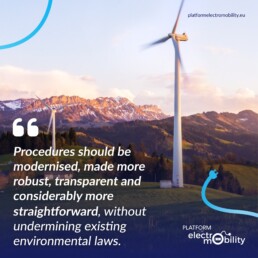
It would be useful to consider the potential links and synergies between the CRM Act and other legislations already in place (such as the environmental and human rights regulations) and to ensure consistency between the various pieces of legislation to meet the needs of the CRM demand sector.
A stable, long-term and fit-for-purpose regulatory basis is the precondition for investing in the EU raw materials value chain. The Act should not overregulate elements of the battery value chain that have already been addressed in other legislation. A particular example is the Batteries Regulation proposal; this has already introduced – among many other sustainability provisions – ambitious recycled content objectives, recycling efficiency and metal recovery targets and detailed responsible sourcing requirements.
Incoherence or duplication between EU chemicals management policies and the Act’s ambition to support the energy transition and climate neutrality objective should also be avoided.
For example, the proposed classification of lithium salts as a ‘known reproductive toxicant’ could have negative consequences for the security of the EU’s lithium supply. Without global scientific agreement or international harmonisation of such classification, such a measure might limit access to lithium for the EU, creating potential problems of supply. The EU must avoid becoming as dependent on minerals as it currently is on oil and gas. Unfortunately, the classification of lithium risks making EU Member States less attractive for lithium mining and refining projects compared to third countries, which remove roadblocks to investing in the lithium value chain. Any such investment would attract excessive levels of uncertainty, due to ambiguities surrounding the risk management measures that the classification could entail in the coming years. Decisions on investments in lithium capacity need to be taken within the next three years in order to be ready for 2030, when global supply constraints are being forecast. Projects need sufficient time to be able to deliver raw materials to the market, hence the market needs to have a clear signal to invest in Europe now.
Efforts must be made, in the context of the 2023 EU Year of Skills, to increase the coverage of CRMs in University Master programmes and to raise awareness around the issue in our next generation workforce. Skills shortages are particularly acute for geology and low-environmental-impact mining specialties, which are currently only present in regions with active mining industries.
Ad hoc incentives would help develop local and more-sustainable supply chains. Policy actions should be defined carefully, and should assess worthy examples adopted by other countries such as tax incentives and innovation funding. Such an approach would also create new jobs at local level and mitigate potential social impacts relating to the energy transition.
Additionally, skills-based visa schemes for raw material professionals currently based in third countries may help fill existing human capital shortages in the short term.
ERMA will play a key role in ensuring a successful approach to critical raw materials, but needs to be further empowered both in governance and financial terms. It requires a mandate to ensure the achievement of European Strategy targets, leading all European Union initiatives on raw materials endowed with all the necessary levers. The current Alliance mechanism for involving players along the value chain should remain; however, as the investment needed will be relevant, it will also be important to support those initiatives that achieve the critical mass to become game changers. Here, it is fundamental that ERMA should have a full overview of the levers that EU is putting in place (regulatory, financial, etc) and that it should be a driving force in implementing the strategy. All raw materials-related initiatives should fall within the overall ERMA framework.
In coordination with ERMA, each Member State should create a National Raw Material Agency (NRMAg) aimed at leading and implementing the national strategy. The structure, tasks and resources of NRMAg should comply with minimum framework requirements as defined at European level.
